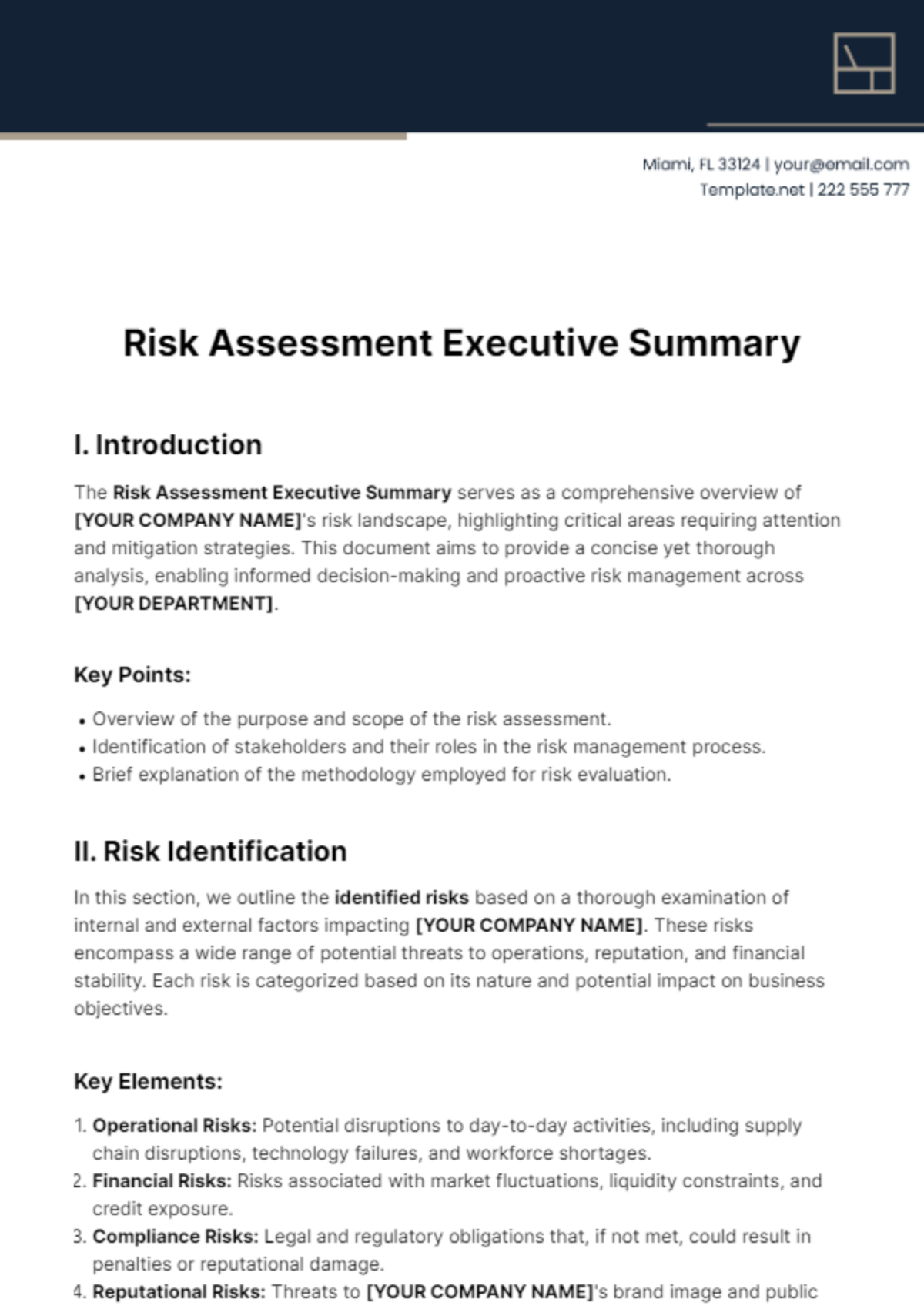Free Risk Assessment Executive Summary

I. Introduction
The Risk Assessment Executive Summary serves as a comprehensive overview of [YOUR COMPANY NAME]'s risk landscape, highlighting critical areas requiring attention and mitigation strategies. This document aims to provide a concise yet thorough analysis, enabling informed decision-making and proactive risk management across [YOUR DEPARTMENT].
Key Points:
Overview of the purpose and scope of the risk assessment.
Identification of stakeholders and their roles in the risk management process.
Brief explanation of the methodology employed for risk evaluation.
II. Risk Identification
In this section, we outline the identified risks based on a thorough examination of internal and external factors impacting [YOUR COMPANY NAME]. These risks encompass a wide range of potential threats to operations, reputation, and financial stability. Each risk is categorized based on its nature and potential impact on business objectives.
Key Elements:
Operational Risks: Potential disruptions to day-to-day activities, including supply chain disruptions, technology failures, and workforce shortages.
Financial Risks: Risks associated with market fluctuations, liquidity constraints, and credit exposure.
Compliance Risks: Legal and regulatory obligations that, if not met, could result in penalties or reputational damage.
Reputational Risks: Threats to [YOUR COMPANY NAME]'s brand image and public perception, arising from negative publicity, customer dissatisfaction, or ethical lapses.
III. Risk Analysis
In this section, we delve deeper into the analysis of identified risks, assessing their likelihood and potential impact on [YOUR COMPANY NAME]'s objectives. Through quantitative and qualitative analysis, we prioritize risks based on their severity and the likelihood of occurrence. Additionally, we explore interconnectedness between risks and their potential cascading effects on the organization.
Key Considerations:
Risk Severity Matrix: Classifying risks based on their potential impact and likelihood, ranging from low to high severity.
Root Cause Analysis: Investigating underlying factors contributing to the emergence of certain risks, enabling targeted mitigation efforts.
Scenario Analysis: Exploring various hypothetical scenarios to assess the resilience of [YOUR COMPANY NAME] to different risk events.
IV. Risk Mitigation Strategies
This section outlines proactive measures to mitigate identified risks and enhance [YOUR COMPANY NAME]'s resilience to potential threats. Each mitigation strategy is tailored to address specific risk factors, aiming to minimize their impact and likelihood of occurrence. Collaboration across departments and proactive monitoring are essential components of successful risk mitigation efforts.
Mitigation Approaches:
Risk Transfer: Utilizing insurance and contractual mechanisms to transfer financial and operational risks to third parties.
Risk Avoidance: Implementing policies and procedures to eliminate or reduce exposure to high-risk activities or environments.
Risk Reduction: Investing in technologies, training programs, and infrastructure upgrades to mitigate the likelihood and severity of identified risks.
Risk Acceptance: Accepting certain risks deemed unavoidable or economically impractical to mitigate, while implementing contingency plans to manage potential consequences.
V. Conclusion
In conclusion, the Risk Assessment Executive Summary provides [YOUR COMPANY NAME] with a comprehensive overview of its risk landscape and actionable insights to enhance resilience and mitigate potential threats. By leveraging the findings and recommendations outlined in this document, [YOUR COMPANY NAME] can proactively manage risks and safeguard its reputation, operations, and long-term viability.
Prepared by: [YOUR NAME]
Date: [DATE]
- 100% Customizable, free editor
- Access 1 Million+ Templates, photo’s & graphics
- Download or share as a template
- Click and replace photos, graphics, text, backgrounds
- Resize, crop, AI write & more
- Access advanced editor
Discover unparalleled convenience with the Risk Assessment Executive Summary Template from Template.net. Crafted for efficiency, this editable and customizable tool streamlines risk evaluation processes. Tailor reports effortlessly using our Ai Editor Tool, ensuring clarity and precision in every executive summary. Elevate your risk management strategy with ease and finesse.





























